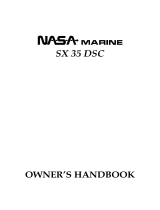
HX851Page 2
TABLE OF CONTENTS
QUICK REFERENCE GUIDE ........................................................................................................ 4
RF EXPOSURE SAFETY STATEMENT .................................................................................... 7
FCC AND CANADA RADIO LICENSE INFORMATION ........................................................... 8
MARITIME STATION LICENSE ............................................................................................ 8
MARINE RADIO CALL SIGN ................................................................................................ 8
CANADIAN SHIP STATION LICENSING ............................................................................... 8
FCC / INDUSTRY CANADA INFORMATION ........................................................................ 8
FCC NOTICE ................................................................................................................................ 9
1 GENERAL INFORMATION .................................................................................................. 10
1.1 INTRODUCTION ....................................................................................................... 10
2 ACCESSORIES ....................................................................................................................11
2.1 PACKING LIST ......................................................................................................... 11
2.2 OPTIONS ................................................................................................................... 11
3 ABOUT THIS RADIO .......................................................................................................... 12
3.1 ABOUT THE VHF MARINE BAND ......................................................................... 12
3.2 EMERGENCY (CHANNEL 16 USE) .......................................................................... 12
3.3 CALLING ANOTHER VESSEL (CHANNEL 16 OR 9) ............................................. 13
3.4 OPERATING ON CHANNEL 13 ............................................................................. 14
3.5 OPERATING ON CHANNEL 67 ............................................................................. 14
4 GETTING STARTED ............................................................................................................ 15
4.1 RADIO CARE ............................................................................................................ 15
4.2 BATTERIES AND CHARGERS ............................................................................... 15
4.3 CONNECTING A CHART PLOTTER TO THE CD-38 ......................................... 19
5 CONTROLS AND SWITCHES ............................................................................................ 20
6 BASIC OPERATION ............................................................................................................ 24
6.1 PROHIBITED COMMUNICATIONS ......................................................................... 24
6.2 INITIAL SETUP ......................................................................................................... 24
6.3 RECEPTION .............................................................................................................. 24
6.4 TRANSMISSION ....................................................................................................... 25
6.5 DISPLAY MODE SETUP ........................................................................................... 26
6.6 USA, CANADA, AND INTERNATIONAL CHANNELS ............................................. 27
6.7 SIMPLEX/DUPLEX CHANNEL USE ....................................................................... 27
6.8 NOAA WEATHER CHANNELS ............................................................................... 28
6.9 SCANNING ................................................................................................................ 29
6.10 DUAL WATCH ........................................................................................................... 31
6.11 PRESET CHANNELS (0 ~ 9): INSTANT ACCESS ................................................. 32
6.12 STROBE LIGHT OPERATION ................................................................................ 33
7 DIGITAL SELECTIVE CALLING ........................................................................................ 34
7.1 GENERAL .................................................................................................................. 34
7.2 MARITIME MOBILE SERVICE IDENTITY (MMSI) ................................................ 34
7.3 DSC DISTRESS ALERT .......................................................................................... 36
7.4 ALL SHIPS CALL ..................................................................................................... 40
7.5 INDIVIDUAL CALL .................................................................................................... 42
7.6 CALL WAITING DIRECTORY .................................................................................. 47
7.7 GROUP CALL ........................................................................................................... 49
7.8 POSITION REQUEST .............................................................................................. 54
7.9 POSITION REPORT ................................................................................................. 59
7.10 GEOGRAPHIC CALL ................................................................................................ 62
7.11 DSC TRANSMISSION TEST ................................................................................... 63





















